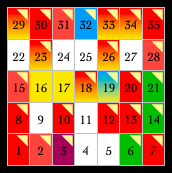#9 - Deciding Card Positioning/ Puzzle Order
As mentioned in previous posts, the game consists of a grid of cards, representative of a graveyard, and the player's goal is to visit them in a particular order, in effort to find their way to a certain one.
I wanted to talk a little about how I created puzzle order, and how I tracked the positions of cards.
ForTracking Card Positions:
Here is a reference chart I used, to give you a visual aid:

The numbers indicate the card position and I color coded the spots for various reasons, like if they are locked to a position, spare (unused in the solving order) cards, or if they needed to be next to another visual element, etc. There is also a comment on each square so when I hovered over it, it says what card it is. Originally, in the comment, I also put what card position that you moved from, and what one it leads to.
That was hard to follow, so I ended up making a second table next to this one. Instead it is plain white with the placement numbers replaced with the solve order number. eg. the first solve, position 5 in that colored map, is instead labelled as 1, and so on. Way easier to reference!
Creating the Puzzle Order
In an earlier post, I believe I touched on my approach to creating puzzles. I want to introduce elements one at a time, so players ease in to what they are looking for. I want the difficulty to slope upward, with that last few being more difficult logic puzzles or riddles.
Given this, I created the cards in puzzle order.
Not to be too spoiler-y, but here are the first three moves:
Move 1: While reading the rules, it references a map (It looks a lot like the grid above). It has the card numbers , no color, and tells the player how to set up the cards. It also indicates the first move. To match what is going on on the map with the starting point.
You would read that card, and since it was picked as an answer, flipped over to reveal the clue that leads directly to card to the right.
Purpose: This first card exemplifies all parts that can be on a card: The grave/visual component, the name, birth/death dates, and inscription/quote text. It also reveals that some cards have information on the reverse.
Move 2-->3: The next card (7, below) shows a man's grave, with text indicating another person. The next card to choose is the wife, with the same headstone, same last name, roughly the same age, and it is located in the same region in the grid of cards.
Purpose: Both are still near-field, close to the front of the graveyard. The goal is to have the player's attention spiral outward in to the other cards. I'm sure some will sit and read a bunch beforehand, but I hope it will take the edge off of the amount of information they are trying to take in at once, for the first few moves at least.


Move 3-->4 : Is interesting, as card (21) indicates a star, and there are 3 cards with stars in them. Comparing details between the cards sets one above the others as the correct move.
Purpose: This introduces the idea of common elements have to be deduced and eliminated. Clues in the text tie in to visual components.
Anyhow, that's it before I get even more spoiler-y. I could probably do a post per card with all the details. I guess I just wanted to map how I was making the foundation. Once I test I'll know if it is successful.
Get Bury Me Where You Will Remember Me
Bury Me Where You Will Remember Me
A Solo, Puzzle-based Card Game
| Status | In development |
| Category | Physical game |
| Author | Well Thought Games |
| Genre | Card Game, Puzzle |
| Tags | Escape Game, Indie, One-shot, relationship, Singleplayer, solo, Story Rich, Tabletop |
| Languages | English |
More posts
- Update 1.2 - Re-visiting the GraveApr 20, 2024
- RememberanceJul 29, 2023
- My Last Words (About the Project)Aug 13, 2022
- The Other CardsAug 13, 2022
- SPOILERS - Answer 24Aug 13, 2022
- SPOILERS - Answer 23Aug 13, 2022
- SPOILERS - Answer 22Aug 13, 2022
- SPOILERS - Answer 21Aug 13, 2022
- SPOILERS - Answer 20Aug 13, 2022
- SPOILERS - Answer 19Aug 12, 2022
Leave a comment
Log in with itch.io to leave a comment.